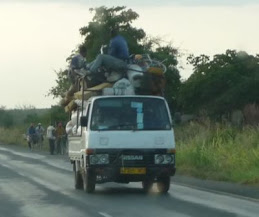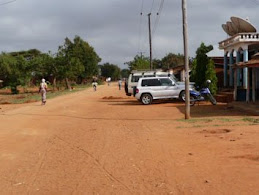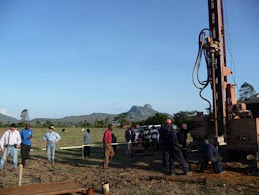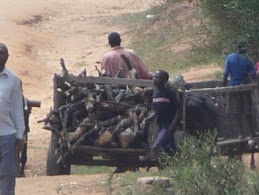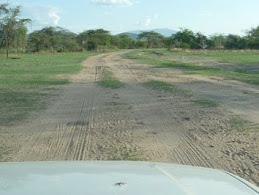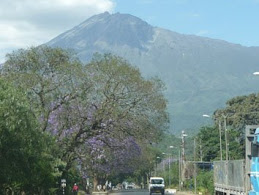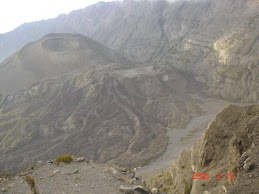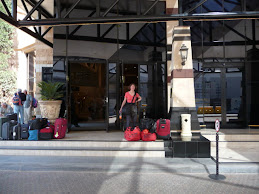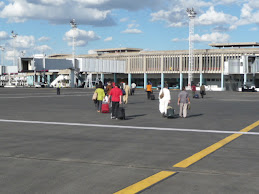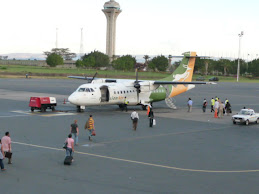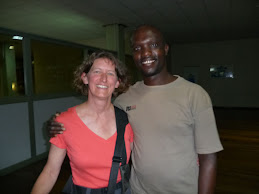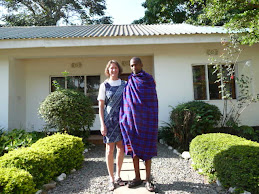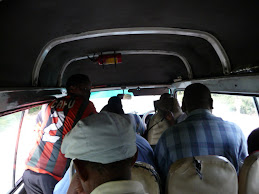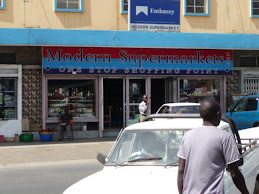Last Sunday (week ago) we were out late helping dig one of the drillers trucks out of a field. It was on a dirt road with bushes on each side close to the truck. I was digging behind the passenger wheel and throwing the dirt/sand out to the side. Somehow I hit a branch with my head and a branch flicked and whipped across my eye scratching it. It hurt quite a bit and made me stop digging and go back down the road to the back of our little Pajero truck where Ramona flushed it with a bottle of clean water she keeps there. It must have been a bit of a scene as there were about 20-30 villagers watching me by this time seeing what was up with the Mzungu. One of our helpers Nik comes up. He speaks no English so uses a lot of actions to communicate with us. He had broken a little branch off a sort of cactus bush that made a white sap come out of it. He was pointing to that and then making a movement like squeezing a women’s breast. After a while we gathered he was saying he would go off and get a lactating women (there are many here) to come and squirt milk into my eye to sooth it. We politely declined and said we were OK.
Things to experience in Africa!
Sunday, February 22, 2009
Saturday, February 7, 2009
Scene from National Geographic
Today we experienced something while drilling that even the drillers were surprised at. It was like being in an episode of National Geographic.
We are currently in this village Luhwaji west of Gairo. Here a village is a collection of several 100 mud houses on dirt roads and trees with maybe 1-2 primary schools. The roads are often poor quality, have no road signs or anything to hint of any money being spent of any official order. Almost no cars, just people walking or maybe on a bicycle. A few water points scattered around with a bunch of women and plastic buckets around them when the water lines are turned on every 3-4th day.
Each village has an chief executive officer who voices that villages affairs to meetings of surrounding villages or to higher up the chain to a ward executive. The CEO will have several executive officers. Then there are some village elders who have respect and can have a say in what goes on. There will be a few essential shops scattered randomly around and usually a pool table on a road side somewhere with a bunch of your males hanging around it.
Luhwaji is relatively flat so I was confident we would find water at 30 to 50 meters deep. The first hole to 30 m was dry so we moved to the next recommended location about 10 m away. The project is having to drill deeper depths everywhere we go. So we are very conscious of drilling extra amounts. At the second site it started out promising then got into hard rock again at about 15 m deep. Ramona and I took one of the village executives with us to go scout out another site (site 5) to drill on in case this current site ends up dry too. We tell this guy that this is no water where we are currently at and we may try this other site.
When we get back the drillers are at 21 m and still dry as a bone. So we stop to take yet another rethink. The executive office who had just been in our car comes over to talk to Jacob the local engineer we are working with who also had just arrived on his motor bike. They go back and join a bunch of others and you could tell they wanted a conference on something. A lot of fast Swahili talking and pointing. We have a crowd of over 300 watching us now and looking at this little conference going on. I make this joke to Ramona that as long as they are not sharpening up their spears we are OK.
Jacob comes back and tells us that the reason we have not found water is that the village elders did not get together and pray for water at this well. They need to pray to their gods and make a blood sacrifice to ensure there will be water for them. So sure enough we all stop working and a group of elders come up to the back of the drill rig with a chicken. We walk a good distance away. They start praying then slaughter the chicken and drip the blood around the well head somewhat. Then we go back and carry on!
The well was still dry however at 60 m where we stopped.
We are currently in this village Luhwaji west of Gairo. Here a village is a collection of several 100 mud houses on dirt roads and trees with maybe 1-2 primary schools. The roads are often poor quality, have no road signs or anything to hint of any money being spent of any official order. Almost no cars, just people walking or maybe on a bicycle. A few water points scattered around with a bunch of women and plastic buckets around them when the water lines are turned on every 3-4th day.
Each village has an chief executive officer who voices that villages affairs to meetings of surrounding villages or to higher up the chain to a ward executive. The CEO will have several executive officers. Then there are some village elders who have respect and can have a say in what goes on. There will be a few essential shops scattered randomly around and usually a pool table on a road side somewhere with a bunch of your males hanging around it.
Luhwaji is relatively flat so I was confident we would find water at 30 to 50 meters deep. The first hole to 30 m was dry so we moved to the next recommended location about 10 m away. The project is having to drill deeper depths everywhere we go. So we are very conscious of drilling extra amounts. At the second site it started out promising then got into hard rock again at about 15 m deep. Ramona and I took one of the village executives with us to go scout out another site (site 5) to drill on in case this current site ends up dry too. We tell this guy that this is no water where we are currently at and we may try this other site.
When we get back the drillers are at 21 m and still dry as a bone. So we stop to take yet another rethink. The executive office who had just been in our car comes over to talk to Jacob the local engineer we are working with who also had just arrived on his motor bike. They go back and join a bunch of others and you could tell they wanted a conference on something. A lot of fast Swahili talking and pointing. We have a crowd of over 300 watching us now and looking at this little conference going on. I make this joke to Ramona that as long as they are not sharpening up their spears we are OK.
Jacob comes back and tells us that the reason we have not found water is that the village elders did not get together and pray for water at this well. They need to pray to their gods and make a blood sacrifice to ensure there will be water for them. So sure enough we all stop working and a group of elders come up to the back of the drill rig with a chicken. We walk a good distance away. They start praying then slaughter the chicken and drip the blood around the well head somewhat. Then we go back and carry on!
The well was still dry however at 60 m where we stopped.
Life of a Tanzanian Driller
Got some good first hand experience of the life of a TZ driller this past 2 weeks.
The first 3 bores we drilled were close to Gairo so it was a 10 min drive back down the road to the town. Then on Wednesday we moved to a village called Mshugi which is 12 km north of Gairo. Big deal you say! It took 8 hours for the drillers to get their trucks there. They use two trucks about 10 ton units I would guess. Tandem back wheels. One has the drill rig on it and the other is a support truck carrying the PVC pipe, water, sand, extra drill rods, shovels etc.
8 hours involved driving on these dirt roads whose condition deteriorates every km further you get from Gairo. It involves crossing 3 river beds which are sand here. One had water two were dry. The one with water had a drop down into it then a steep climb back up the other side on a uneven dirt/sand surface so traction was poor at best. They got stuck here big time in the sand. It took them 3 hours to dig themselves out and then redig them out again and again. They do know how to get these trucks unstuck I must say with no fancy tools. Just bags they fill with sand, any branches or small logs lying around, a log wire rope if the first truck gets thru and the 2nd gets stuck the first can pull it through some times. We help as we can but they are a hard working team. Then got stuck 3 more times before reaching the site.The drill truck has hydraulic feet on it which they lower down when drilling to take the weight off the wheels and importantly to level the truck so they are drilling vertically not on an angle. So they use this truck to go first. Originally this truck had 4 wheel drive and a third drive shaft and associated transfer box that they use to drive the hydraulics for the drilling mast. However this transfer box broke a while ago we hear, so now the truck has no 4 wd and when they want to use the hydraulics they have to get under the truck and disconnect the rear wheel drive shaft and connect in a shorter drive shaft to run the hydraulics. Then when they want to drive again they have to undo the hydraulics drive shaft and put in the wheels drive shaft. If the truck is in the middle of running river bed then they do it in the water as there is no option.
So when this rig truck gets stuck they use these hydraulic feet to jack the truck up off the ground, pack bags of sand under the wheels and then logs if possible to provide a drive path for the next meter or so to allow the truck to get some speed up if possible. It works most of the time.
The 2nd truck has no hydraulic feet so it goes 2nd and if it gets stuck they connect a long 1” wire rope to the first truck on the other side, and the stuck truck and then pull it through. This takes hours to do every time in many cases. They must be used to it as they just get out and get on with it without too much complaining at all, more joking with each other. They get covered in sand and water and mud when there is surface water around.
Due to the difficulty of getting the trucks around and no little support pick up available, the drillers just stay out on site. Cook their food over a charcoal cooker, no washing, little laundry, sometimes restricted water, a bed either in the truck seats or a piece of foam on the ground.
After finishing the first bore at Mshugi they were to move on Sat night to the second site for the village. Ramona and I left them to pack up the trucks and then leave. It was not too far away. On Sunday morning we drove back out there which takes even us an hour to go 12 km in the little Pajero across all the same dirt trails and river beds. It is so easy to get lost out there as the villagers just walk everywhere so there are dirt trails criss-crossing all over. We get about ¾ of the way there and come across them stuck in another river bed where they were not meant to be. Apparently some villager had given them some confusing directions. This time the support truck had gone first for some reason and it was a steep drop down into the sandy bed and a climb out the other side. It was stuck big time. They had gotten stuck the night before and had been up all night working to get it out as if you leave it to sit it gets even more stuck. So they were trashed by the time we got there. They were about ready to try to tow the support truck out backwards again with the rig truck. The wire rope is about 50 ft long. They did manage to pull the truck out, however the rig truck then stopped pulling and the truck being towed out backwards could not see that and he was racing the truck backwards to make sure he got up the incline before getting stuck again. He slammed into the rig truck big time. Wham! Luckily no damage done to the rig truck but the folded up mast hit the canopy frame on the support truck and bent it to heck. The rig truck drives up the road another 50 yards to clear out of the way. So we all get over that and then discuss where they really were meant to have gone. It was a narrow dirt road with maize crops either side making the ground soft. This means the trucks cannot turn around until they drive back up to the intersection a few 100 yards up the road. The rig truck is still about 50 yards away when the drive of the support truck starts to back his truck up again. He races back again and you could see what was going to happen. The drilling foreman and Ramona were running up the road chasing the support truck driving backwards. The driver was looking at the rear wheels to make sure he did not get off the dirt road so did not see them yelling and waving and WHAM again into the back of the rig truck. Two 10 ton trucks colliding at 20 mph, ouch. This time there was damage to the rig truck but only to some accessories and not the important parts. It is not even my equipment and I felt sick to the stomach to see this.
Having recovered from that bit of excitement, we continued on to the real site and got stuck again in the very next river bed about 5 mins away! This was dry sand so not too bad, only an hour or so to dig them out and change the drive shafts around again. At that point I said to the foreman, let’s take a ride in our Pajero to scout the rest of the route to this last distant well as I now have serious doubts about the trucks getting there. This we did and he decided quite quickly that I was right and so we abandoned that last position. The local villagers were meant to make it more accessible too but had done nothing so they now get left off the drilling schedule. We turned the trucks around to head back to a village closer to Gairo and immediately get stuck again in the river crossing we had just gotten them out of an hour before. Another hour or two for the drillers to dig themselves out and change the drive shafts around. I said to the foreman, let’s get them to site and take the rest of the day off as they must be exhausted by now. Which we did and they were grateful to find a big tree to park under in the shade and go to sleep.
That is a hard life.
The first 3 bores we drilled were close to Gairo so it was a 10 min drive back down the road to the town. Then on Wednesday we moved to a village called Mshugi which is 12 km north of Gairo. Big deal you say! It took 8 hours for the drillers to get their trucks there. They use two trucks about 10 ton units I would guess. Tandem back wheels. One has the drill rig on it and the other is a support truck carrying the PVC pipe, water, sand, extra drill rods, shovels etc.
8 hours involved driving on these dirt roads whose condition deteriorates every km further you get from Gairo. It involves crossing 3 river beds which are sand here. One had water two were dry. The one with water had a drop down into it then a steep climb back up the other side on a uneven dirt/sand surface so traction was poor at best. They got stuck here big time in the sand. It took them 3 hours to dig themselves out and then redig them out again and again. They do know how to get these trucks unstuck I must say with no fancy tools. Just bags they fill with sand, any branches or small logs lying around, a log wire rope if the first truck gets thru and the 2nd gets stuck the first can pull it through some times. We help as we can but they are a hard working team. Then got stuck 3 more times before reaching the site.The drill truck has hydraulic feet on it which they lower down when drilling to take the weight off the wheels and importantly to level the truck so they are drilling vertically not on an angle. So they use this truck to go first. Originally this truck had 4 wheel drive and a third drive shaft and associated transfer box that they use to drive the hydraulics for the drilling mast. However this transfer box broke a while ago we hear, so now the truck has no 4 wd and when they want to use the hydraulics they have to get under the truck and disconnect the rear wheel drive shaft and connect in a shorter drive shaft to run the hydraulics. Then when they want to drive again they have to undo the hydraulics drive shaft and put in the wheels drive shaft. If the truck is in the middle of running river bed then they do it in the water as there is no option.
So when this rig truck gets stuck they use these hydraulic feet to jack the truck up off the ground, pack bags of sand under the wheels and then logs if possible to provide a drive path for the next meter or so to allow the truck to get some speed up if possible. It works most of the time.
The 2nd truck has no hydraulic feet so it goes 2nd and if it gets stuck they connect a long 1” wire rope to the first truck on the other side, and the stuck truck and then pull it through. This takes hours to do every time in many cases. They must be used to it as they just get out and get on with it without too much complaining at all, more joking with each other. They get covered in sand and water and mud when there is surface water around.
Due to the difficulty of getting the trucks around and no little support pick up available, the drillers just stay out on site. Cook their food over a charcoal cooker, no washing, little laundry, sometimes restricted water, a bed either in the truck seats or a piece of foam on the ground.
After finishing the first bore at Mshugi they were to move on Sat night to the second site for the village. Ramona and I left them to pack up the trucks and then leave. It was not too far away. On Sunday morning we drove back out there which takes even us an hour to go 12 km in the little Pajero across all the same dirt trails and river beds. It is so easy to get lost out there as the villagers just walk everywhere so there are dirt trails criss-crossing all over. We get about ¾ of the way there and come across them stuck in another river bed where they were not meant to be. Apparently some villager had given them some confusing directions. This time the support truck had gone first for some reason and it was a steep drop down into the sandy bed and a climb out the other side. It was stuck big time. They had gotten stuck the night before and had been up all night working to get it out as if you leave it to sit it gets even more stuck. So they were trashed by the time we got there. They were about ready to try to tow the support truck out backwards again with the rig truck. The wire rope is about 50 ft long. They did manage to pull the truck out, however the rig truck then stopped pulling and the truck being towed out backwards could not see that and he was racing the truck backwards to make sure he got up the incline before getting stuck again. He slammed into the rig truck big time. Wham! Luckily no damage done to the rig truck but the folded up mast hit the canopy frame on the support truck and bent it to heck. The rig truck drives up the road another 50 yards to clear out of the way. So we all get over that and then discuss where they really were meant to have gone. It was a narrow dirt road with maize crops either side making the ground soft. This means the trucks cannot turn around until they drive back up to the intersection a few 100 yards up the road. The rig truck is still about 50 yards away when the drive of the support truck starts to back his truck up again. He races back again and you could see what was going to happen. The drilling foreman and Ramona were running up the road chasing the support truck driving backwards. The driver was looking at the rear wheels to make sure he did not get off the dirt road so did not see them yelling and waving and WHAM again into the back of the rig truck. Two 10 ton trucks colliding at 20 mph, ouch. This time there was damage to the rig truck but only to some accessories and not the important parts. It is not even my equipment and I felt sick to the stomach to see this.
Having recovered from that bit of excitement, we continued on to the real site and got stuck again in the very next river bed about 5 mins away! This was dry sand so not too bad, only an hour or so to dig them out and change the drive shafts around again. At that point I said to the foreman, let’s take a ride in our Pajero to scout the rest of the route to this last distant well as I now have serious doubts about the trucks getting there. This we did and he decided quite quickly that I was right and so we abandoned that last position. The local villagers were meant to make it more accessible too but had done nothing so they now get left off the drilling schedule. We turned the trucks around to head back to a village closer to Gairo and immediately get stuck again in the river crossing we had just gotten them out of an hour before. Another hour or two for the drillers to dig themselves out and change the drive shafts around. I said to the foreman, let’s get them to site and take the rest of the day off as they must be exhausted by now. Which we did and they were grateful to find a big tree to park under in the shade and go to sleep.
That is a hard life.
Can of Sprite
Our well drilling is being as successful as we had hoped. The area is very dry and making us drill a lot deeper than originally planned which is using up the budget faster. Yesterday we were drilling in Mkalama village about 7 km from Gairo. We were close to an old (2002) abandoned well and while we were waiting on the drillers to drill more, we got to having a look at it to see why it had been abandoned. Turns out the hand pump on the top of the well had lost its bottom check valve and the villagers had never replaced it so the NGO who installed the pump came and took it away they villagers said. It is a $40 part and they had been without water from this well for about 5 years now. They were using a nearby open pit to get all their water from. Open to surrounding area run off, animals to come to, and their own washing So we figured if we got the villagers to clean out the well we could put a new pump on it and get them a lot of clean water from this sealed well. It was a 1 m diameter well as compared to the 20 cm diameter well we were drilling nearby. This old well flows at 1000 lph where as our drilled one flows at 75 lph. (different circumferential inflow areas) We chipped the concrete cap away to expose a 1 m diameter round lid and flipped it over to the side to get access to the well. It was about 4 m deep with 3 m of water and sticks in it that the locals kids and put in there over time. One of the local villagers striped down to his shorts and then put a long log down the well to act as a ladder! so he could climb down into it. Others on top lowered down a bucket on rope to him to fill the bucket then they would pull it up and dump its contents off to the side. This poor guy down the well would get water spilt all over him as they lifted it up and stones and dirt kicked down on him from the workers above. He was down there for about 4 hours filling this bucket time and time again. But he did a great job.
When he finally came out I gave him a can of Sprite for his efforts. This is one of the Aluminium cans with the pull tab. He put it on the ground not really knowing what it was let alone how to open it. This old Masai shepherd came in his purple red wrap around and staff, and peered at the can, picking it up looking at the top and bottom and the ring. It was like a scene from ‘The Gods must be Crazy’ movie as he had obviously never seen a soda can before and didn’t know what to make of it. They left taking the unopened can with them.
You see some weird things here at times.
When he finally came out I gave him a can of Sprite for his efforts. This is one of the Aluminium cans with the pull tab. He put it on the ground not really knowing what it was let alone how to open it. This old Masai shepherd came in his purple red wrap around and staff, and peered at the can, picking it up looking at the top and bottom and the ring. It was like a scene from ‘The Gods must be Crazy’ movie as he had obviously never seen a soda can before and didn’t know what to make of it. They left taking the unopened can with them.
You see some weird things here at times.
Tuesday, February 3, 2009
Deforestation
One activity you can’t help notice as you drive around Tanzania is that in addition to a lot of women carrying buckets of water on their head there is an equally large amount of people carrying fire wood around. At quite often intervals along the road side you see bags of chopped up fire wood for sale. This appears to be quite an industry for young men. The road site sale locations vary from 1-2 bags for sale to over 30 bags in some places. The men just go back into the bush off the road and cut down the trees then cut it up into smaller pieces for the buyer to use in their cooking. The bags are quite big and heavy so you see them more being transported on bicycles. Bicycles are used more to load up for transport. The rider then pushes the bike around with its load on the back as it is too heavy and unstable to try to ride. Sometimes there are 2 of these large bags on a bike which makes for a very large load. Or you will see women walking along with bundles of sticks on their heads, or if it is a bigger branch, then maybe a single piece of wood on their head. Less frequently you will see whole acreages cleared with the stacked up logs and branches ready for moving away. Most of the forest here is small trees or scrub so there is little construction quality or size wood available. There are some fences around houses or stock pens made of smaller diameter branches though that the owners put up. Similar to the water problem there is no practical way for the rural villagers to get fuel to cook their meals other than to go find it. This means cutting down trees or branches themselves or to go buy these bags of cut up wood. There is no electricity to speak of run to these rural village houses. Even if someone could afford to install the infrastructure for running power lines to all these villages, the people there more than likely could not afford to buy electricity. Likewise they cannot afford to buy bottle propane gas and they would have trouble transporting it around if they could. Consequently there is no real infrastructure to buy bottled gas anyway in these rural locations. Those that could afford it would have to travel a long way to purchase some, which requires a lot of time as the transport would likely be a bicycle or a bullock drawn cart.
From the west we encourage the villagers to boil surface water before they use it for consumption, but this requires yet more wood to be burned so there is an extra cost to them to do this.
The population appears to be growing fast in these regions. There are a lot of women carrying babies on their backs. A rough unofficial count as we watch women walk by our work sites is that about 50% of them have a baby. Many young unmarried women have children we hear. We recently heard by a person who was at a speech put on by the president of a Children’s Fund that approx 40% of these babies do not make it to 5 yrs old though. A growing population means more fire wood is needed every year.
A climb up onto a high cliff and looking around will soon reveal to the observer that vast tracks of land are bare but for a few trees scattered around. The constant grazing of the cattle and goats by roving herders keeps any grass to a short level. Some areas are devoid of much vegetation just bareish dirt/sand. A growing population of people means a growing population of cows and goats too.
In the long run deforestation of large areas of land is a cost we will all pay with changing weather patterns. There may also be necessary support of a large number of people on a land that can no longer support them. Not to even mention what this is doing to the very valuable tourist resource of the large wild animals in these countries. The governments of these countries that are home to these big animals are meant to be their guardians, yet we seem to be trading in lions and elephants for more cows and goats.
We are told there are some programs, but to date we have not seen any attempts to farm trees to make a sustainable situation where by the trees cut down this year are replaced so that eventually each village would have its own renewing plantation to harvest their wood from. This would solve more than just the wood for the villagers problems too, the whole world would benefit at some global level.
From the west we encourage the villagers to boil surface water before they use it for consumption, but this requires yet more wood to be burned so there is an extra cost to them to do this.
The population appears to be growing fast in these regions. There are a lot of women carrying babies on their backs. A rough unofficial count as we watch women walk by our work sites is that about 50% of them have a baby. Many young unmarried women have children we hear. We recently heard by a person who was at a speech put on by the president of a Children’s Fund that approx 40% of these babies do not make it to 5 yrs old though. A growing population means more fire wood is needed every year.
A climb up onto a high cliff and looking around will soon reveal to the observer that vast tracks of land are bare but for a few trees scattered around. The constant grazing of the cattle and goats by roving herders keeps any grass to a short level. Some areas are devoid of much vegetation just bareish dirt/sand. A growing population of people means a growing population of cows and goats too.
In the long run deforestation of large areas of land is a cost we will all pay with changing weather patterns. There may also be necessary support of a large number of people on a land that can no longer support them. Not to even mention what this is doing to the very valuable tourist resource of the large wild animals in these countries. The governments of these countries that are home to these big animals are meant to be their guardians, yet we seem to be trading in lions and elephants for more cows and goats.
We are told there are some programs, but to date we have not seen any attempts to farm trees to make a sustainable situation where by the trees cut down this year are replaced so that eventually each village would have its own renewing plantation to harvest their wood from. This would solve more than just the wood for the villagers problems too, the whole world would benefit at some global level.
Ramona Injury
Last Wednesday Ramona and I were throwing an American football around out in the dirt street with some of the neighbouring kids before dark. They are 6-12 yrs old probably and full of enthusiasm. Some can manage quite a throw. Ramona went to catch a good throw and caught it on her little left finger first. She said ouch then a few seconds later said "I need help". Her little finger was sticking out sideways, it appeared to have been dislocated at the first joint up from the knuckle. I thought this has to go back in now as we are a long way from anywhere for real medical help. So I pulled on the finger and it dropped back into place thankgoodness and Ramona could immediately bend it as normal. She is quite brave indeed while I was cringing. The next few days the joints turned purple then that faded back to normal. It is still a little swollen however between the knuckle and that first joint.
Critters
A few weeks ago we had a small 8" long snake in our lounge when we came home one night. Tonight Ramona found a small scorpion trapped in the Mosquito net over our bed!
Subscribe to:
Posts (Atom)
































































































































